Importing Lightwright Data Into Eos Family Consoles
To access the Lightwright Import feature, go to the Browser and select:
File>Import> Lightwright>Location of file to be imported> File name.txt
Eos will only display *.txt files in this menu. Additionally, Eos will only successfully import a tab delineated file with windows character returns.
If you are a Mac user you must pay close attention to how you export your file from Lightwright. Mac will sometimes remove the .txt from the file extension. You may need to manually add this back to the file name in the finder on Mac.
During the import process Eos is looking from the following column headers; Purpose, Channel, Dimmer, Color, Circuit Name, Circuit#, and Device Type.
Import Map:
|
EOS < ver.1.2.0 |
Lightwright 4 |
Lightwright 5 |
|
Channel |
Channel |
Channel |
|
Address |
Dimmer |
Dimmer |
|
Text 1 |
Circuit# |
Circuit# |
|
Text 2 |
Circuit Name |
Circuit Name |
|
Text 3 |
Color |
Color |
|
Text 4 |
Purpose |
Purpose |
|
Notes (not a query field) |
||
|
Not mapped. If "Light" is in the field, Eos import allows the associated fields to map. REQUIRED FOR IMPORT |
Device Type(Instrument type has to be fixture to be marked as "Light" other instrument types will NOT import) |
Device Type(all instrument types export as "Light". Fixtures with multiple attributes only patch the first line. Import will not select your fixture type in patch.) |
It is extremely important to note that Eos will not import any rows that say anything other than "Light" in the "Device Type" column. Lightwright 4 will change the fields listed in the device type column based on what Instrument type you use. On the other hand Lightwright 5 seems to input "Light" for every instrument type. I have yet to figure out if this "Device Type" field will change under any circumstance in LW5. There is not a direct way to change this field inside the Lightwright program.
Where to Begin? The process is different depending on your Lightwright version.
If you have Lightwright 4...
Start by opening the Lightwright Show file you wish to import.
Click on File>Export>Data
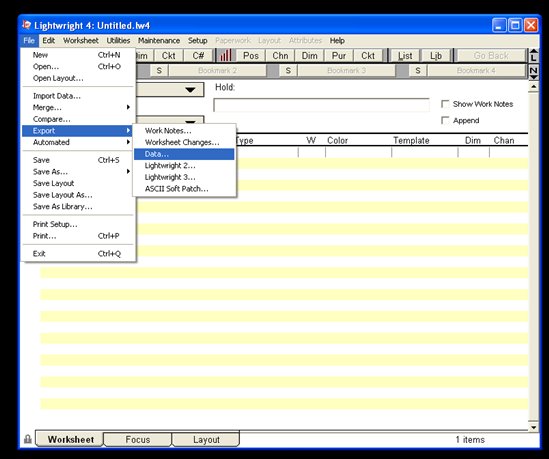
This will bring you into the "export options" dialogue box.
From here the simple sure-fire-way is to place a check mark next to every field in the white scrolling window. But you could just select the fields you wish to import. The device type is not optional.
NOTE: Eos only reads the following fields:
Purpose
Channel
Dimmer
Color
Circuit Name
Circuit#
Device Type (THIS IS A REQUIRED FIELD)
Place another check mark in the box next to the following options:
"Export field labels as first record"
"Strip channel parentheses ()".
Additionally, make sure the radio button is selected for "Tab Separated" in the Export File Type box. If you are a Mac user you will have to replace the Mac character returns with Windows character returns. (This is done in the actual Text file and can be a bit cumbersome. LW5 make this much simpler.)
Your window should look like the following screen shot. Then click on "OK"
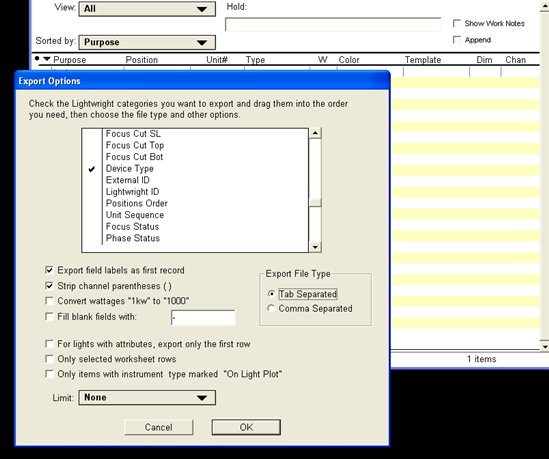
This should bring you to the Export File dialog box. Here you can give your file a name. It is important to save it with a *.TXT file extension. Eos will not see it otherwise. (It is recommended that you export it right to your USB drive.) Then Click "Save"
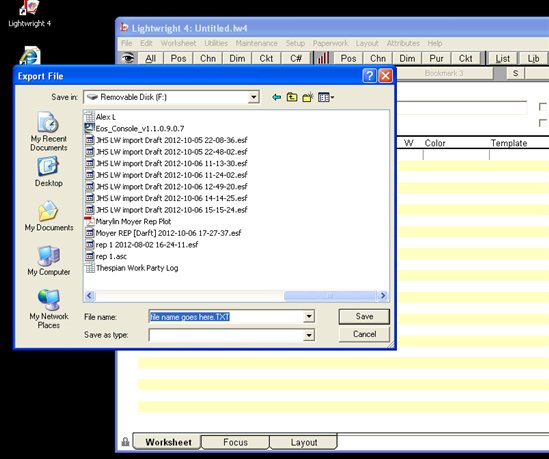
If you have Lightwright 5...
Start by opening the Lightwright Show file you wish to import.
Click on File>Export>Data
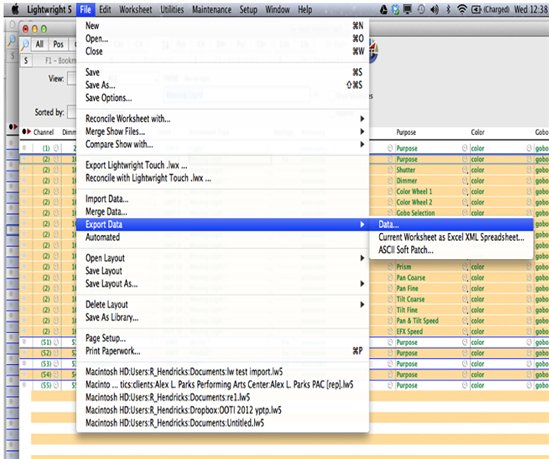
This will bring you into export options.
From here the simple sure-fire way is to place a check mark next to every field in the scrolling window to the left. But you could just select the fields you wish to import. The device type is not optional. It must be selected.
NOTE: Eos only reads the following fields: (note that in LW5 you can order these fields any way you please. Though it has no bearing on how the information will import into Eos.)
- Purpose
- Channel
- Dimmer
- Color
- Circuit Name
- Circuit#
- Device Type (THIS IS A REQUIRED FIELD)
Make sure the radio button is selected for "All Worksheet Data" and "Tab Separated".
Place another check mark in the box next to the following options:
- "Export field labels as first record"
- "Strip channel parentheses ()".
- Mac users will additionally have to mark"Use Microsoft Windows Line Endings"
Your window should look like the following screen shot. Then click on "Export the data"
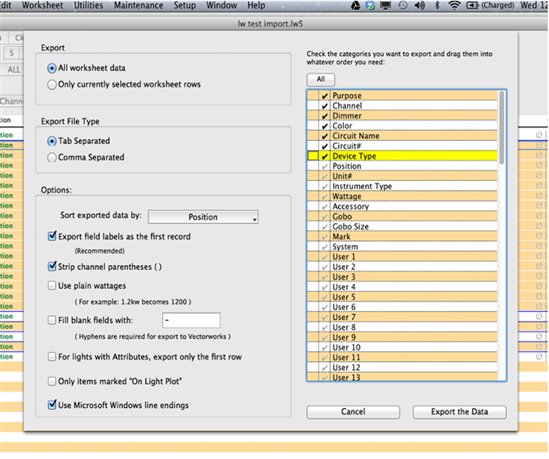
This should bring you to the Export File dialog box. Here you can give your file a name. It is important to save it with a *.TXT file extension. Eos will not see it otherwise. (It is recommended that you export it right to your USB drive.) Then Click "Save".
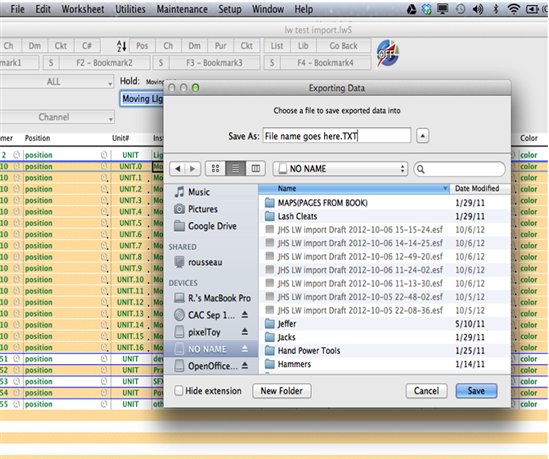
THE NEXT STEP...
After exporting your Lightwright 4 or Lightwright 5 file, import your file into Eos.
- Place the USB drive that contains your exported *.TXT file into an available USB port on the Eos console.
- Navigate in the browser to Lightwright import.
File> Import> Lightwright - Locate your USB drive and navigate to the file you wish to import.
- Highlight the file name and press [select].
- You will be prompted with "Do you really want to import items into your show?". You may need to click on Map Devices in order to associate the text from Lightwright to a profile in Eos. (For more information on this process please go to the Eos Family Online eManual and look at the page for "Importing Show Data")
- Once Device Mapping is complete hit OK.
